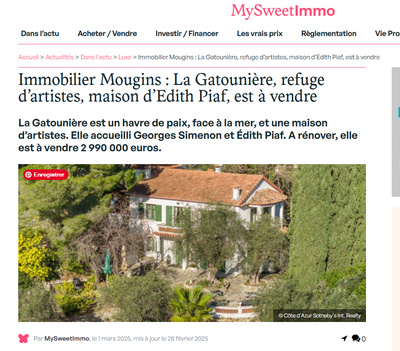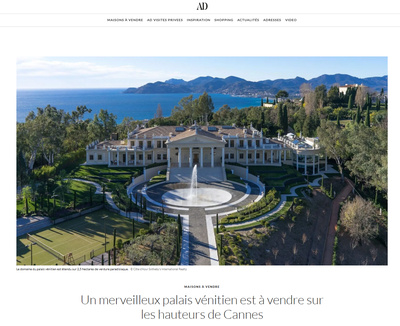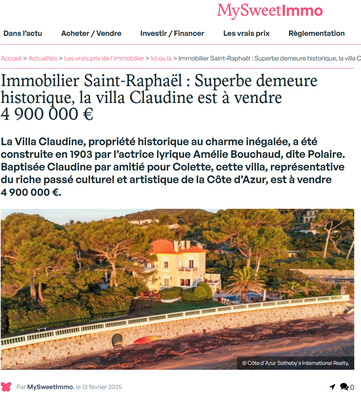Sotheby's International Realty
- 74 boulevard de la Croisette
- 06400 CANNES, France
- +33 4 92 92 12 88
Sotheby's International Realty
- 37 boulevard Marinoni
- 06310 BEAULIEU SUR MER, France
- +33 4 92 92 12 88
Sotheby's International Realty
- 3 avenue Denis Semeria
- 06230 SAINT JEAN CAP FERRAT, France
- +33 4 92 92 12 88
Sotheby's International Realty
- 9 avenue Paul Roussel
- 83990 SAINT TROPEZ, France
- +33 4 92 92 12 88
Sotheby's International Realty
- 5 rue Longchamp
- 06000 NICE, France
- +33 4 92 92 12 88
Press Financial Times - Chateau Lerins

Discover Château Lérins, a centuries-old jewel nestling near Cannes, meticulously restored according to the principles of English decorative art. This remarkable building, once a monastery, is a rare example of residential architecture designed in France by the famous British architect Edwin Lutyens.
Edwin Lutyens, a renowned British architect, was known for his artistic versatility. While closely associated with the Arts and Crafts movement, he demonstrated his ability to embrace a variety of architectural styles, from Queen Anne (as exemplified by The Salutation in Kent) to Art Deco (as exemplified by 100 King Street in Manchester) to medieval architecture (as exemplified by Castle Drogo in Devon, the last castle built in England). His influence extended far beyond the UK, with iconic projects in India, where he played a key role in the design of New Delhi, including the Viceroy's Residence which is now the Presidential Palace. He also made his mark in Ireland, the United States and South Africa.
Unfortunately, his residential work in France has often gone unnoticed. One of these little-known treasures is Château Lérins, a sumptuous 19-bedroom residence in the south of France, now up for sale for €25 million. The three-storey structure was originally a sheepfold before the monks of the nearby Îles de Lérins converted it into a monastery in the 17th century.
Guillaume Mallet, heir to a French banking fortune, entrusted Lutyens with the task of transforming the château. A chance meeting between the two men in Paris, while Lutyens was working on the British pavilion for the 1900 Universal Exhibition, had already given rise to two previous projects: an Arts and Crafts renovation in Normandy and a similar holiday home nearby. In 1912, Lutyens was commissioned to completely rethink the monastery at Ranguin, just 5 miles from Cannes. The result of his work was anything but monastic.
As described by art historian Emmanuel Ducamp, Lutyens skilfully transformed the old building into a classical house, both majestic and refined. He added loggias and balconies on either side of the structure, offering uninterrupted views of the mountains of the Estérel massif and the Mediterranean Sea.
As for the interior, although less well documented than other works by Lutyens, it is clear that his artistic influence was omnipresent. The double-height vaulted entrance hall, the chequered floor, the panelled library and the grand drawing room with its marble fireplace all bear Lutyens' distinctive mark. In addition, the Edwardian balcony beds adjacent to the master bedrooms, a common feature of many Lutyens-designed homes, confirm his imprint.
Exterior decorative details, such as doors and windows, closely match Lutyens' designs, while the terraced gardens and flights of stone steps, designed to suit the sloping terrain surrounding the house, also bear the hallmark of this renowned architect. The property offers a wealth of facilities, including a large swimming pool, pool house, tennis court, gym, caretaker's cottage and, typically in the south of France, a pétanque court. The estate's majestic olive trees are estimated to be over 1,000 years old.
Château Lérins has had a rich history, passing through the hands of different families over the decades. Before the Second World War, it was sold by the Mallet family. Subsequently, it was the residence of Frederick Glyn, the fourth Baron of Wolverton, whose widow leased the property to Joseph Kennedy, the United States Ambassador to the United Kingdom in 1939. Joseph Kennedy's son, the future President John F. Kennedy, stayed in this magnificent house.
The property was later owned by French film producer Bernard Chevry. Today, this architectural marvel is up for sale, offering an opportunity to acquire a piece of history and art in the south of France.
According to local legend, Napoleon spent the night at Château Lérins before heading north on his return from exile in 1815. Whether or not this is true, Château Lérins is, according to Hanson, "one of Lutyens' major works, on a par with the restoration and transformation of Lindisfarne Castle in Northumberland".
Today, it offers a new owner the chance to share in several centuries of history.
Don't miss the chance to own a jewel on the Côte d'Azur that will turn your dreams into reality. Contact Frédéric Barth to find out more and to arrange a visit.
Read the dedicated article on the Financial Times website
For more information, see our property listing







